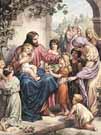
|
|
|

|

|

|

|
|
Click on an image to see a larger, more detailed picture.
|
|
|
|
|
| PROLOGUE: Roots of the Holocaust |

|
pg. 43 |

|
|
|
|
| |
 Jesus, a Jew, taught and lived by the tenets of Judaism. He was killed by Romans who feared his unique leadership.
Jesus, a Jew, taught and lived by the tenets of Judaism. He was killed by Romans who feared his unique leadership.
Photo: Archive Photos
|
 Rome brutally put down Jewish rebellion in 70 c.e., destroying Jerusalem and the sacred Second Temple.
Rome brutally put down Jewish rebellion in 70 c.e., destroying Jerusalem and the sacred Second Temple.
Photo: Archive Photos
|
 A converted Christian, Emperor Constantine ended persecution of Christians and granted the religion official recognition. He imposed a series of edicts oppressive to Jews.
A converted Christian, Emperor Constantine ended persecution of Christians and granted the religion official recognition. He imposed a series of edicts oppressive to Jews.
Photo: Archive Photos: F11858E
|
|
Jews, of course, are not a race, because any person, irrespective of "blood" or any other biological feature, can become a Jew by conversion. Nevertheless, the belief that Jews are a race caught on. Such thinking had immense implications and vast consequences. If Jewishness was a racial matter, then it could be argued that Jewish identity was determined by heredity, Jewish character by biological inheritance. According to this racist outlook, Jews could do nothing to change their identity and character. It made no difference whether they converted to Christianity or displayed patriotic love for their country. According to the beliefs of racist antisemites, a Jew was a Jew no matter what, and Jews were a menace to the "superior" non-Jewish societies in which they lived. Racial antisemitism meant that the very existence of Jewish life had become a problem that required a solution. Once linked, antisemitism and racism energized each other. But racial antisemitism could never have arisen had it not been for the nonracial forms of antisemitism that were at its roots. Although Jewish identity is ordinarily passed from parent to child, anyone, in principle, can be Jewish. Therefore, Nazi ideology to the contrary notwithstanding, racial characteristics cannot define Jews in any "essential" way. Jews have to be identified in other ways before it is possible to impute racial identity to them. Thus, behavior--what Jews do or do not do--becomes critical in defining identity prior to the imputation of racial differences. Behavior, however, is also problematic in establishing distinctively Jewish identity--at least that is true if one focuses only on the work that Jews do, the professions they practice, the economic plans or political persuasions they possess. For in and of themselves, those roles can usually be filled by all kinds of people. There is, however, at least one distinguishing and far-ranging behavioral difference. Not all Jews are religious. Nevertheless, religion is at the core of differences that originally set Jews apart. Religion involves more than particular beliefs. It lives in specific practices, too. Jews not only worshiped one God exclusively, but they also observed a special Sabbath and distinctive holidays, such as Passover. They practiced circumcision, adhered to special dietary restrictions, and regarded Jerusalem as the Holy City. Informed by Judaism, their singular religion, Jews were unique. In addition, religious particularity is crucial when it comes to understanding the anti-Jewish feelings that have long been embedded in Christianity. Absent Christian hostility toward Jews, it would be extremely difficult, if not impossible, to explain why Jews were so consistently targets for discrimination and persecution in Western civilization and why, specifically, they were eventually set up for the kill in Hitler's Germany.
|
|

|

|

|

|
 1925: In the United States, Rev. Gerald B. Winrod founds Defenders of the Christian Faith, an antisemitic group that attacks "Jewish bolshevism." Winrod is dubbed "the American Streicher."
1925: In the United States, Rev. Gerald B. Winrod founds Defenders of the Christian Faith, an antisemitic group that attacks "Jewish bolshevism." Winrod is dubbed "the American Streicher."
|
 February 27, 1925: A large rally in Munich, Germany, relaunches the Nazi Party. Four thousand people attend.
February 27, 1925: A large rally in Munich, Germany, relaunches the Nazi Party. Four thousand people attend.
|
 March 24, 1925: Publication of the pro-Nazi, antisemitic newspaper Der Stürmer resumes after being banned by the Weimar government in November 1923.
March 24, 1925: Publication of the pro-Nazi, antisemitic newspaper Der Stürmer resumes after being banned by the Weimar government in November 1923.
|
 April 26, 1925: Paul von Hindenburg is elected president of Germany.
April 26, 1925: Paul von Hindenburg is elected president of Germany.
|
 June 1925: The Geneva Conventions Protocol prohibits wartime use of asphyxiating, poisonous, and other gases, as well as bacteriological warfare.
June 1925: The Geneva Conventions Protocol prohibits wartime use of asphyxiating, poisonous, and other gases, as well as bacteriological warfare.
|
|
|
|
|
| PROLOGUE: Roots of the Holocaust |

|
pg. 43 |

|
|
The Holocaust Chronicle
© 2009 Publications International, Ltd.
|
|
